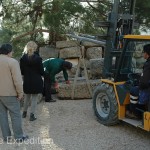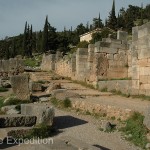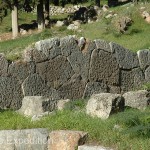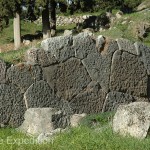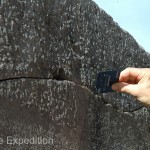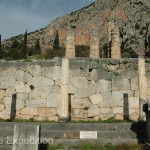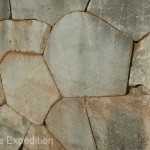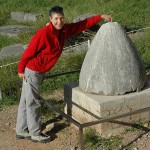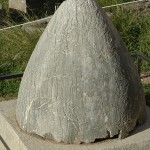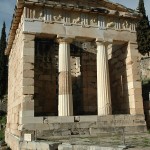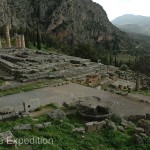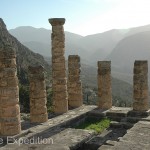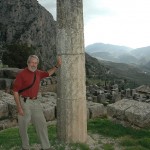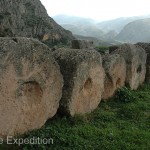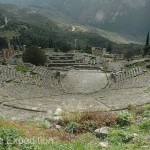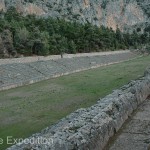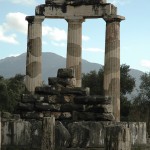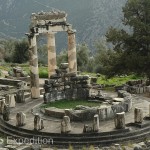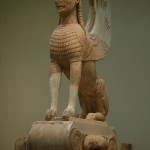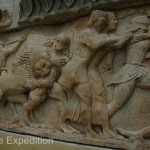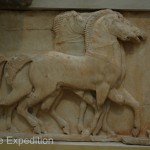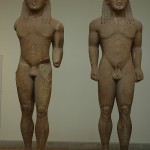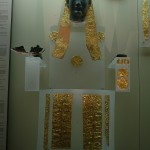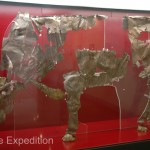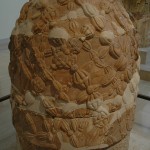Delphi, Greece – 1/2014
This is an introduction to Greek Mythology. There will be a short quiz when we leave Greece and Zeus will be watching you!
Leaving our peaceful overnight camp at the small fishing village of Monastiraki, we drove to Delphi, the most important Ancient Greek site of Oracles. If you glance at a map of Greece, there are hundreds of ruins and major archeological sites, most of whose dates end in “BC”. Occupation of the site at Delphi can be traced back to the Neolithic ( New Stone Age) period with extensive occupation and use beginning in the Mycenaean period (1600–1100 BC). Many of the ruins surviving today date from the most intense period of activity in the 6th century BC.
In mythology going back to the Classic Period of Ancient Greece (510-323 BC), the site of Delphi was believed to have been chosen by Zeus. For thousands of years in what we now call “Western Civilization”, Zeus was the head “God”. There were other Gods and Goddesses beneath him, (He loved to delegate.), but he had the final word and he was worshiped by learned philosophers like Aristotle and Socrates and a major part of the world before they discovered it was not flat.
Of course Zeus must have known that, so when he sought to find the centre of his Grandmother Earth “Gaia”, he sent two eagles flying from the eastern and western extremities. The path of the eagles crossed over Delphi where a stone was placed called the omphalos to mark the navel of Gaia.
Apollo, one of Zeus’s sons, had his sacred precinct in Delphi. It was also a Pan-Hellenic sanctuary, where every four years, starting in 586 BC, athletes from all over the Greek world competed in the Python Games, one of the four Pan-Hellenic games, precursors of the Modern Olympics.
Delphi would have been a renowned city whether or not it hosted these games. It had other attractions that led to it being labeled the “omphalos” (navel) of the earth, in other words, the center of the world. (Later that was changed to France.)
According to Greek Mythology a serpent or dragon called Python had attempted to rape Leto, one of Zeus’s lovers while she was pregnant with the twins Apollo and Artemis. (Zeus was quite a playboy.) Apollo killed Python but had to be punished for it, since Python was a child of Gaia. That’s a long story.
There was a spring that flowed toward the temple of Athena but disappeared beneath the rocks creating a cleft. When Apollo slew Python, it fell into this fissure.
Apollo spoke through an Oracle. The sibyl or priestess of this Oracle at Delphi was known as the Pythia. She had to be an older woman of blameless life chosen from among the peasants of the area. She sat on a tripod seat over an opening in the earth. Intoxicated by the vapors from the decomposing body of Python, the sibyl would fall into a trance, allowing Apollo to possess her spirit. In this state she prophesied the future. (It has been speculated that a gas high in ethylene, known to produce violent trances, came out of this opening, though this theory remains debatable.)
Many votive statues, and numerous “treasuries” were built by the various Greek city-states — those overseas as well as those on the mainland — to commemorate victories and to thank the oracle for Pythia’s (Apollo’s) advice, which was thought to have contributed to those victories. They were called “treasuries” because they held the offerings made to Apollo; these were frequently a “tithe” or tenth of the spoils of a battle. Sort of like an early version of the Vatican Museum?
We could not offer any significant sacrifices to learn the future of our adventure along the Silk Road, so we were content to wander the grounds and could only imagine what it might have looked like thousands of years ago.
- Ever wonder how the ancient Greeks moved those huge stones? Now you know.
- Many of Delphi’s buildings have been partially restored.
- Though smaller in size, the intricate cutting and placement of stones in many of the walls reminded us of those in the Incan ruins of Peru like Machu Picchu and Sacsayhuaman.
- The sacred omphalos (navel) of Delphi was identified with a stone marking the spot where the eagles sent by Zeus to discover the center of the earth had crossed.
- The best-preserved monument of the Apollonian Sanctuary is the Treasury of Athenians, built of white marble and dedicated to Apollo Pythios by the Athenian citizens.
- The temple of Apollo survived until 390 AD, when the Christian emperor Theodosius I silenced the oracle by destroying the temple and most of the statues and works of art in the name of Christianity.
- The site was completely destroyed by zealous Christians in an attempt to remove all traces of Paganism.
- Earthquakes, battles, vandalism and time have taken their toll on the ruins of Delphi.
- The Delphi Theater was the stage for plays and musical competitions. It could seat 5,000 spectators.
- Starting in 586 BC, the Stadium of Delphi was the center for the Pythian Games every four years. These were one of the four Pan-Hellenic games, precursors of the Modern Olympics.
- Life finds a way to adorn the ancient walls of Delphi, perhaps a small tribute to Apollo.
- The Tholos in the Sanctuary of the goddess Athena is a masterpiece of ancient Greek architecture due to its rich sculpted decoration. She was worshiped as the patroness of wisdom, fertility and health.
- Three of the Doric columns have been restored, making it the most popular site at Delphi for tourists to take photographs.
- The archaeological museum attached to the Delphi ruins held many of the treasures found during the extensive excavation.
- The archaeological museum attached to the Delphi ruins held many of the treasures found during the extensive excavation.
- These proudly pacing horses give an example of the unique modeling of archaic art.
- A pair of marble kouroi, possibly two heroes from Argive Mythology, was the work of a workshop of Argos, circa 580 BC.
- Many treasures of gold were discovered during excavations.
- This statue of a bull was created from three sheets of silver. Its horns, ears, forehead, hooves and other body parts were gilded.
- The marble omphalos in the museum is regarded as a Hellenistic or Roman copy of the stone marking the center of Gaia, Mother Earth.



